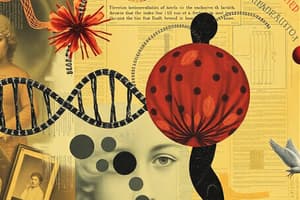Podcast
Questions and Answers
What type of cells have a nucleus?
What type of cells have a nucleus?
- Protists
- Prokaryotes
- Animals
- Eukaryotes (correct)
Which organelle is responsible for photosynthesis in plants?
Which organelle is responsible for photosynthesis in plants?
- Cell membrane
- Chloroplasts (correct)
- Ribosomes
- Mitochondria
What is the main difference between fungi and plants in terms of food production?
What is the main difference between fungi and plants in terms of food production?
- Fungi make their own food through photosynthesis, plants consume other organisms for food
- Fungi are autotrophs, plants are heterotrophs
- Plants make their own food through photosynthesis, fungi must consume other organisms for food (correct)
- Fungi have chloroplasts, plants do not have chloroplasts
Which type of fungi steals nutrients unwillingly from other living organisms?
Which type of fungi steals nutrients unwillingly from other living organisms?
In which domain are eukaryotic cells found?
In which domain are eukaryotic cells found?
What is the sum of all chemical reactions in the cell called?
What is the sum of all chemical reactions in the cell called?
Where does photosynthesis primarily occur in plant cells?
Where does photosynthesis primarily occur in plant cells?
Which of the following is a reactant in cellular respiration?
Which of the following is a reactant in cellular respiration?
What is the main purpose of photosynthesis?
What is the main purpose of photosynthesis?
Which type of plant lacks true roots, stems, or leaves?
Which type of plant lacks true roots, stems, or leaves?
In which organelle does cellular respiration primarily occur?
In which organelle does cellular respiration primarily occur?
Which of the following is a product of photosynthesis?
Which of the following is a product of photosynthesis?
Study Notes
Cell Structure and Functions
- Eukaryotic cells have a nucleus, which houses genetic material and controls cellular activities.
- Prokaryotic cells, such as bacteria, lack a nucleus and are simpler in structure.
Photosynthesis
- The chloroplast is the organelle responsible for photosynthesis in plants, converting light energy into chemical energy.
- Photosynthesis primarily occurs in the chloroplasts of plant cells, particularly in the leaves.
- Reactants in photosynthesis include carbon dioxide and water, while glucose and oxygen are its products.
Food Production
- The main difference between fungi and plants in terms of food production lies in their modes: plants produce food via photosynthesis, while fungi are heterotrophic, absorbing nutrients from their surroundings.
Types of Fungi
- Parasitic fungi steal nutrients from living organisms without their consent, often harming the host in the process.
Cellular Respiration
- Cellular respiration primarily occurs in the mitochondria, which generate ATP for energy.
- The sum of all chemical reactions in the cell is known as metabolism.
Plant Characteristics
- Bryophytes, such as mosses, lack true roots, stems, or leaves, distinguishing them from vascular plants.
Biological Domains
- Eukaryotic cells are found within the domain Eukarya, which includes animals, plants, fungi, and protists.
Studying That Suits You
Use AI to generate personalized quizzes and flashcards to suit your learning preferences.
Description
This quiz covers important topics for the biology test on Unit 11, including Fungi, Plants, Photosynthesis, and Types of Plants. It also includes an overview of cellular classification of Fungi and Plants, different types of cells, cell parts for Eukaryotic cells, and an overview of photosynthesis and cellular respiration.




